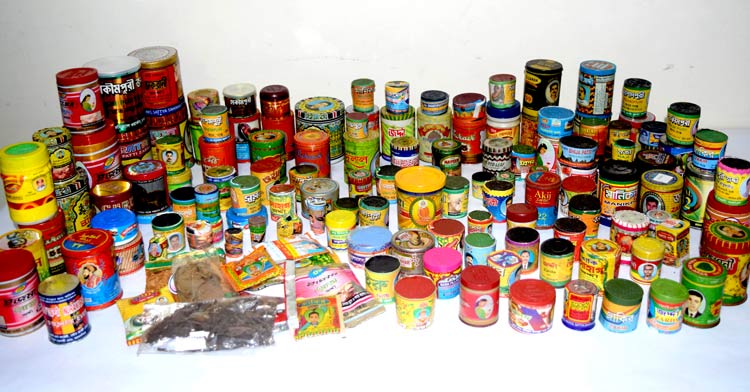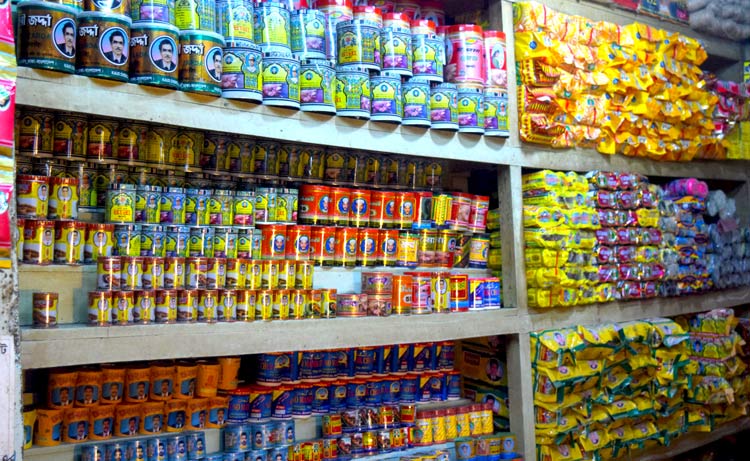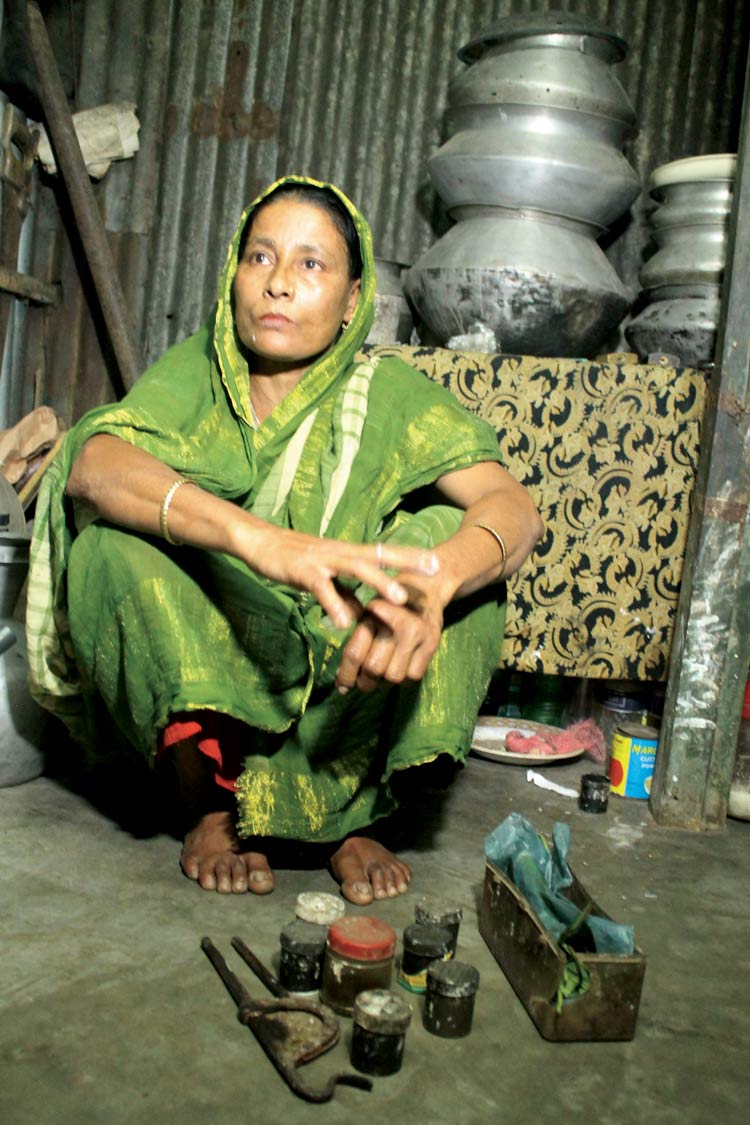Smokeless Tobacco in Bangladesh: Zarda, Sadapata and Gul sdf
 Tamak Birodhi Nari Jote (TABINAJ) || Sunday 30 September 2018 ||
Tamak Birodhi Nari Jote (TABINAJ) || Sunday 30 September 2018 ||
Smokeless tobacco (SLT) constitutes more than 50% of tobacco use among men and women in Bangladesh. Yet, it has received less attention in tobacco control policies and actions because of perceived less harmful health effects than smoking and social and cultural acceptance of its use in Bangladesh.
Bangladesh is one of the South Asian countries, where 80% of all smokeless tobacco are consumed as these are integral to culture, being incorporated in their traditional values, spirituality, beliefs, festivals, marriage ceremonies, lifestyle, rituals and popular entertainment [1].
Smokeless tobacco (SLT) is included in the definition of Tobacco products under the “Smoking and Tobacco Products Usage (Control) Act, 2005 (amended in 2013)”. Three most used smokeless tobacco products, Zarda, Sadapata and Gul are included in the Act.
Smokeless Tobacco use in Bangladesh: Global Adult Tobacco Survey, 2017 [2]
Overall tobacco users: 35.3% (37.8 million adults)
Smoked tobacco users: 18% (19.2 million adults)
Smoking is higher among men: 36.2% men, 0.8% women
Smokeless tobacco users: 20.6% (22.0 million adults), 18.7% use betel quid with tobacco, 3.6% use gul.
Smokeless tobacco use is higher among women: 16.2% men and 24.8% women
63.6% of current smokeless tobacco users last purchased tobacco from stores
Media projection is less on smokeless tobacco: only 23.9% of adults noticed anti-smokeless tobacco information on the television or radio, as opposed to 46.2% adults noticing anti-smoking information.
Knowledge and perception about health effects of smokeless tobacco: 82.0%, 82.5% and 91.0% believed using smokeless tobacco causes stroke, heart attack and oral/mouth cancer respectively
Very cheap products
Most of the tobacco users consume smokeless tobacco - zarda, gul, sadapata with betel leaf. The price of smokeless tobacco products, especially zarda, sadapata and gul is very low. The lowest price is BDT 2 to 5. The weight and price of Zarda 10 gram, price BDT 12, Sadapata sold as piece at BDT 6. Small Gul packet is found between Tk 4 to Tk. 8. It is easily available among the people of lower income group.
The highest price of Zarda: weight 140 gram, Price BDT 280

Normal price of Zarda: weight 30 gram Price BDT 40
There are many brands of Zarda. Tabinaj collection of most used brands in 2013 was 225 in the market. Top ten brands that are in the market are 1. Hakimpuri 2. Shova 3. Ratan 4. Baba 5. ManikVijapati 6. Akijzarda 7. Jafrani 8. National Pat zarda 9. DulalZarda 10. ShuroviZarda. These are not in order of ranking and vary in different markets. Except Akij, the companies are confined to the business of Zarda. Akij also produces biri known as Aki jBiri.
Other studies [3] found 832 brands of Zarda and 54 brands of Gul in 25 districts in 2017.
There is wide variety of pack sizes and shapes. 27 different pack sizes, mostly round shaped, are found in the market.
Printing of Graphical Health Warning about the harms of tobacco products are mandatory on the packets but it is not properly complied with. Graphical Health Warning (GHW) as per Law is not followed properly on zarda and gul packets due to different shape and type of packets. 76% of the smokeless tobacco products have GHW, out of which 44% did not follow the requirement of the Law [3].
Addictive and harmful for health
All tobacco products are inherently harmful, including smokeless tobacco, which contain over 2000 chemical compounds, including nicotine. Smokeless tobacco may also cause heart disease by acutely elevating blood pressure and contributing to chronic hypertension. Associations between smokeless tobacco use and fatal myocardial infarction and stroke are also found [4].
SLT users have very high levels of cotinine (380ng/ml [GSD:2]) compared to cigarette smokers. High cotinine concentration among SLT users and increased prevalence of SLT use in Bangladesh indicate that SLT products are highly addictive and SLT users need adequate support to give up this behavior [5].
There are 49,000 oral cancer, 71,000 pharynx &larygeal cancer and 196,000 lung cancer cases in Bangladesh; out of which 3.6% of the admissions in medical college hospitals are due to cancers of oral cavity, larynx and lung [6].
Other reported health problems are there including reproductive health problems with pregnant women delivering low weight babies and still birth etc.
The sellers and users are aware about the health impact of cigarette and bidi but they know little about the harms of zarda and gul.

Ingredients in Smokeless tobacco products
Ingredients in tobacco products are used to increase their attractiveness, addictiveness, and toxicity. Tobacco product ingredients are the substances, components, and raw materials that when put together make up a tobacco product ready to be used. Tabinaj investigation on ingredients show the main ingredients of Zarda are:
Categories Ingredients
Ingredients for Attractiveness Natural & artificial flavors & added perfume, natural and synthetic flavor, natural perfume
Ingredients for Attractiveness Tobacco
Toxicity ingredients Color, food color
Additives spices, molasses, cinnamon, menthol, saccharine, glucose, glycerine, vegetable oil, Gum Arabic, Mrigonavi (Musk)
Non-tobacco Plant material Papaya, Herbs, Joyfal, jostimodhu, saffron

The ingredients are listed in the Zarda packs in very small prints, but hardly any user reads. Most of the users are also illiterate or have low education level.
Unregulated Production of Zarda and Gul
The production of Zarda and Gul are in a very unregulated and unorganized sector, mostly found as household production units, small factories without any signs and are not registered with government revenue authorities. Therefore very little information is available on actual production quantities, amount sold in the market through wholesale and retail market and amount used by consumers. The production and processing of Sadapata is even more difficult to find out. There are 123 Zarda factories around the country and 23 gul factories found in 38 district in 8 divisions [7]
Use of Women and Child labour in production and selling
At Production Level: Child labour is used in the Zarda and Gul factories to reduce cost and increase profit as they can pay a lower rate for a wage. Most of them are casual labours and are unprotected.

Selling: Smokeless tobacco products are sold in tea stalls and small grocery shops. Minor children are being engaged for selling zarda with paan as vendors. The national Anti-Tobacco Law prohibits selling/buying to and from under-aged persons.

Taxation on SLT
For smokeless tobacco (SLT), Tobacco control groups proposed the elimination of the Ex-Factory Price in Smokeless Tobacco (zarda and Gul) and set a minimum retail price of 50 taka per 20 grams. Raise the ad valorem tax to 45% of price and add a specific tax of 10 taka per 20g in the 2018-19 FY budget [8].
However, in the National Budget the government fixed 10 grams of Zarda and Gul at Tk 25 for fiscal year 2018-19 . [9]
References:
- Gupta PC, Ray CS. Smokeless tobacco and health in India and South Asia. Respirology 2003
- GATS, Fact Sheet, Bangladesh 2017, WHO, GOB, CDC and Bangladesh Bureau of Statistics
- Situation of Graphical Health Warning Compliance on smokeless tobacco products, A study in 25 districts by Tobacco Control and Research Cell (TCRC) , Dhaka International University, 25 April, 2017
- World No Tobacco Day 2018: Tobacco breaks hearts – choose health, not tobacco. Geneva: World Health Organization; 2018 (WHO/NMH/PND/18.4). Licence: CC BY-NC-SA 3.0 IGO.
- Huque R, Shah S, Mushtaq N, Siddiqi K (2016) Determinants of Salivary Cotinine among Smokeless Tobacco Users: A Cross-Sectional Survey in Bangladesh. PLoS ONE 11(8): e0160211. doi:10.1371/journal.pone.0160211
- Impact of Tobacco related illness in Bangladesh, WHO 2005 in National Cancer Control Strategy and Plan of Action, 2009 – 15, NCD Line Director, DGHS, MOHFW
- Investigation of Factories of smokeless tobacco products, 2014, Tabinaj, unpublished www.ubinig.org
- Progga Fact Sheet on WNTD, 2018
- Financial Express “More charges on Tobacco products” June 7, 2018
Note: These information are given from the surveys and investigations by members of Tabinaj and other materials of tobacco control groups in Bangladesh. TamakBirodhiNariJote (TABINAJ) is the first alliance of women in tobacco control in Bangladesh which has taken up anti-tobacco campaign to save women, men and children from the hazards of tobacco. It is working against smoking and use of smokeless tobacco products. The Alliance is against tobacco cultivation and use of women and child labour in the hazarduousbiri industry. Tabinaj is actively lobbying for necessary amendments in the Tobacco Control Law for its effective implementation particularly to control smokeless tobacco. Over 100 Tabinaj member organisations are working in all 64 districts of the country.
Tabinaj is affiliated with UBINIG (Policy Research for Development Alternative) and NarigranthaPrabartana acts as its secretariat.